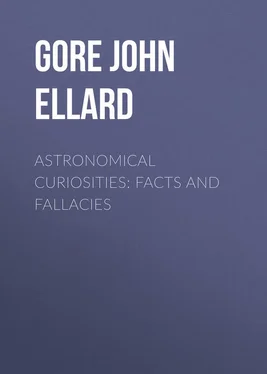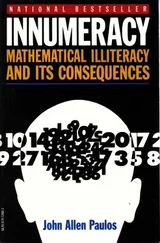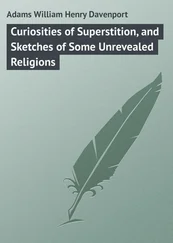John Gore - Astronomical Curiosities - Facts and Fallacies
Здесь есть возможность читать онлайн «John Gore - Astronomical Curiosities - Facts and Fallacies» — ознакомительный отрывок электронной книги совершенно бесплатно, а после прочтения отрывка купить полную версию. В некоторых случаях можно слушать аудио, скачать через торрент в формате fb2 и присутствует краткое содержание. Жанр: Физика, foreign_antique, foreign_prose, на английском языке. Описание произведения, (предисловие) а так же отзывы посетителей доступны на портале библиотеки ЛибКат.
- Название:Astronomical Curiosities: Facts and Fallacies
- Автор:
- Жанр:
- Год:неизвестен
- ISBN:нет данных
- Рейтинг книги:5 / 5. Голосов: 1
-
Избранное:Добавить в избранное
- Отзывы:
-
Ваша оценка:
- 100
- 1
- 2
- 3
- 4
- 5
Astronomical Curiosities: Facts and Fallacies: краткое содержание, описание и аннотация
Предлагаем к чтению аннотацию, описание, краткое содержание или предисловие (зависит от того, что написал сам автор книги «Astronomical Curiosities: Facts and Fallacies»). Если вы не нашли необходимую информацию о книге — напишите в комментариях, мы постараемся отыскать её.
Astronomical Curiosities: Facts and Fallacies — читать онлайн ознакомительный отрывок
Ниже представлен текст книги, разбитый по страницам. Система сохранения места последней прочитанной страницы, позволяет с удобством читать онлайн бесплатно книгу «Astronomical Curiosities: Facts and Fallacies», без необходимости каждый раз заново искать на чём Вы остановились. Поставьте закладку, и сможете в любой момент перейти на страницу, на которой закончили чтение.
Интервал:
Закладка:
CHAPTER IV
The Earth
The earth being our place of abode is, of course, to us the most important planet in the solar system. It is a curious paradox that the moon’s surface (at least the visible portion) is better known to us than the surface of the earth. Every spot on the moon’s visible surface equal in size to say Liverpool or Glasgow is well known to lunar observers, whereas there are thousands of square miles on the earth’s surface – for example, near the poles and in the centre of Australia – which are wholly unknown to the earth’s inhabitants; and are perhaps likely to remain so.
Many attempts have been made by “paradoxers” to show that the earth is a flat plane and not a sphere. But M. Ricco has found by actual experiment that the reflected image of the setting sun from a smooth sea is an elongated ellipse. This proves mathematically beyond all doubt that the surface of the sea is spherical; for the reflection from a plane surface would be necessarily circular . The theory of a “flat earth” is therefore proved to be quite untenable, and all the arguments (?) of the “earth flatteners” have now been – like the French Revolution – “blown into space.”
The pole of minimum temperature in the northern hemisphere, or “the pole of cold,” as it has been termed, is supposed to lie near Werchojansk in Siberia, where a temperature of nearly -70° has been observed.
From a series of observations made at Annapolis (U.S.A.) on the gradual disappearance of the blue of the sky after sunset, Dr. See finds that the extreme height of the earth’s atmosphere is about 130 miles. Prof. Newcomb finds that meteors first appear at a mean height of about 74 miles. 56 56 Bulletin, Ast. Soc. de France , August, 1905.
An aurora seen in Canada on July 15, 1893, was observed from stations 110 miles apart, and from these observations the aurora was found to lie at a height of 166 miles above the earth’s surface. It was computed that if the auroral “arch maintained an equal height above the earth its ends were 1150 miles away, so that the magnificent sight was presented of an auroral belt in the sky with 2300 miles between its two extremities.” 57 57 Nature , April 5, 1894.
“Luminous clouds” are bright clouds sometimes seen at night near the end of June and beginning of July. They appear above the northern horizon over the sun’s place about midnight, and evidently lie at a great height above the earth’s surface. Observations made in Germany by Dr. Jesse, and in England by Mr. Backhouse, in the years 1885-91, show that the height of these clouds is nearly constant at about 51 miles. 58 58 Nature , May 14, 1896. Some have attributed these “luminous clouds” to light reflected from the dust of the Krakatoa eruption (1883).
The present writer has seen these remarkable clouds on one or two occasions in County Sligo, Ireland, during the period above mentioned.
M. Montigny has shown that “the approach of violent cyclones or other storms is heralded by an increase of scintillation” (or twinkling of the stars). The effect is also very evident when such storms pass at a considerable distance. He has also made some interesting observations (especially on the star Capella), which show that, not only does scintillation increase in rainy weather, but that “it is very evident, at such times, in stars situated at an altitude at which on other occasions it would not be perceptible at all; thus confirming the remark of Humboldt’s with regard to the advent of the wet season in tropical countries.” 59 59 The Observatory , 1877, p. 90.
In a paper on the subject of “Optical Illusions” in Popular Astronomy , February, 1906, Mr. Arthur K. Bartlett, of Batter Creek, Michigan (U.S.A.), makes the following interesting remarks: —
“The lunar halo which by many persons is regarded as a remarkable and unexplained luminosity associated with the moon, is to meteorological students neither a mysterious nor an anomalous occurrence. It has been frequently observed and for many years thoroughly understood, and at the present time admits of an easy scientific explanation. It is an atmospheric exhibition due to the refraction and dispersion of the moon’s light through very minute ice crystals floating at great elevations above the earth, and it is explained by the science of meteorology, to which it properly belongs; for it is not of cosmical origin, and in no way pertains to astronomy, as most persons suppose, except as it depends on the moon, whose light passing through the atmosphere, produces the luminous halo, which as will be seen, is simply an optical illusion, originating, not in the vicinity of the moon – two hundred and forty thousand miles away – but just above the earth’s surface, and within the aqueous envelope that surrounds it on all sides… A halo may form round the sun as well as the moon … but a halo is more frequently noticed round the moon for the reason that we are too much dazzled by the sun’s light to distinguish faint colours surrounding its disc, and to see them it is necessary to look through smoked glass, or view the sun by reflection from the surface of still water, by which its brilliancy is very much reduced.”…
“A ‘corona’ is an appearance of faintly coloured rings often seen around the sun and moon when a light fleecy cloud passes over them, and should not be mistaken for a halo, which is much larger and more complicated in its structure. These two phenomena are frequently confounded by inexperienced observers.” With these remarks the present writer fully concurs.
Mr. Bartlett adds —
“As a halo is never seen except when the sky is hazy, it indicates that moisture is accumulating in the atmosphere which will form clouds, and usually result in a storm. But the popular notion that the number of bright stars visible within the circle indicates the number of days before the storm will occur, is without any foundation whatever, and the belief is almost too absurd to be refuted. In whatever part of the sky a lunar halo is seen, one or more bright stars are always sure to be noticed inside the luminous ring, and the number visible depends entirely upon the position of the moon. Moreover, when the sky within the circle is examined with even a small telescope, hundreds of stars are visible where only one, or perhaps two or three, are perceived with the naked eye.”
It is possible to have five Sundays in February (the year must of course be a “leap year”). This occurred in the year 1880, Sunday falling on February 1, 8, 15, 22, and 29. But this will not happen again till the year 1920. No century year (such as 1900, 2000, etc.) could possibly have five Sundays in February, and the Rev. Richard Campbell, who investigated this matter, finds the following sequence of years in which five Sundays occur in February: 1604, 1632, 1660, 1688, 1728, 1756, 1784, 1824, 1852, 1880, 1920, 1948, 1976. 60 60 Popular Astronomy , vol. 11 (1903), p. 293.
In an article on “The Last Day and Year of the Century: Remarks on Time Reckoning,” in Nature , September 10, 1896, Mr. W. T. Lynn, the eminent astronomer, says, “The late Astronomer Royal, Sir George Airy, once received a letter requesting him to settle a dispute which had arisen in some local debating society, as to which would be the first day of the next century. His reply was, ‘A very little consideration will suffice to show that the first day of the twentieth century will be January 1, 1901.’ Simple as the matter seems, the fact that it is occasionally brought into question shows that there is some little difficulty connected with it. Probably, however, this is in a great measure due to the circumstance that the actual figures are changed on January 1, 1900, the day preceding being December 31, 1899. A century is a very definite word for an interval respecting which there is no possible room for mistake or difference of opinion. But the date of its ending depends upon that of its beginning. Our double system of backward and forward reckoning leads to a good deal of inconvenience. Our reckoning supposes (what we know was not the case, but as an era the date does equally well) that Christ was born at the end of B.C. 1. At the end of A.D. 1, therefore, one year had elapsed from the event, at the end of A.D. 100, one century, and at the end of 1900, nineteen centuries… It is clear, then, that the year, as we call it, is an ordinal number, and that 1900 years from the birth of Christ (reckoning as we do from B.C. 1) will not be completed until the end of December 31 in that year, the twentieth century beginning with January 1, 1901, that is (to be exact) at the previous midnight, when the day commences by civil reckoning.” With these remarks of Mr. Lynn I fully concur, and, so far as I know, all astronomers agree with him. As the discussion will probably again arise at the end of the twentieth century, I would like to put on record here what the scientific opinion was at the close of the nineteenth century.
Читать дальшеИнтервал:
Закладка:
Похожие книги на «Astronomical Curiosities: Facts and Fallacies»
Представляем Вашему вниманию похожие книги на «Astronomical Curiosities: Facts and Fallacies» списком для выбора. Мы отобрали схожую по названию и смыслу литературу в надежде предоставить читателям больше вариантов отыскать новые, интересные, ещё непрочитанные произведения.
Обсуждение, отзывы о книге «Astronomical Curiosities: Facts and Fallacies» и просто собственные мнения читателей. Оставьте ваши комментарии, напишите, что Вы думаете о произведении, его смысле или главных героях. Укажите что конкретно понравилось, а что нет, и почему Вы так считаете.











